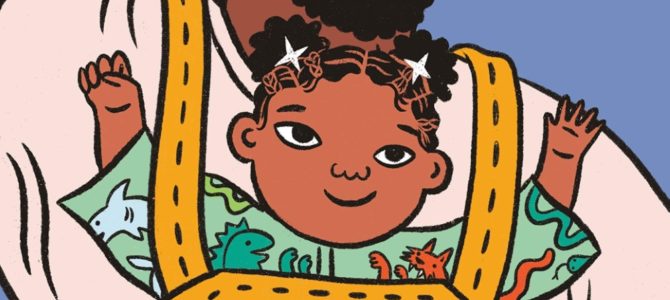
If you’ve been fretting over how to explain critical race theory to your baby, you’re in luck, and the wait is over. Finally, bestselling author Ibram X. Kendi has gifted us his wisdom, packaged for the very young, published by Penguin Random House.
Kendi boils down the complex and ever-changing definition of “racist” and “racism” into nine, easily-digestible and simple steps packaged sweetly for newborns to three-year-olds. Even more, this book gives you more than just critical race theory as Kendi gently guides your baby toward not just being an antiracist but also becoming a budding political activist.
Antiracist Baby contains smiling cartoon characters (some hairy, some sporting tattoos) peppered throughout its pages on non-primary-colored panels. It opens with this verse:
Antiracist Baby is bred not born.
Antiracist Baby is raised
to make society transform.
In the illustration, people are at a protest with their fists in the air and holding signs such as “Equity now!” “Black Lives Matter,” and “Environmental justice is racial justice.” Many words and phrases on this page may be foreign to your tike, but don’t worry, this is a great opportunity for the child to quickly gain critical race theory vocabulary.
The next spread tells the reader in Rule No. 1 to “Open your eyes to all the skin colors”:
Antiracist Baby learns all the colors,
not because race is true.
If you claim to be color-blind,
You deny what’s right in front of you

You might wish to pause and ponder the rhyme’s meaning of “not because race is true,” but do not worry—your baby will understand what this means.
The second rule states:
No one will see racism if we only stay silent.
If we don’t name racism,
it won’t stop being so violent.

This close up of an illustration makes the message clear: If your baby is white then, as usual, she will climb the ladder of success and happiness and receive every trophy without effort. Brown and black babies are plumb out of luck.
The third rule states, “Babies are taught to be racist or antiracist—there’s no neutrality.” This is another opportunity for your baby to learn a high school-level word. Clearly, if babies aren’t being active in their antiracism, such as protesting police departments and voting for policies like reparations, then they are racists.
“Some people get more, while others get less…because policies don’t always grant equal access” reads lesson three.

In the illustration, the brown baby wants the butterfly but it’s far out of reach, so far that it’s on the facing page. Meanwhile, the tiny white-privileged arm is grabbing a net full of colorful butterflies.
Just as Catholics require going to confession, so does Antiracist Baby, as explained by Rule No. 7: “Confess when being racist.”
Some of the other “rules” are fairly simple, such as asking children to love one another and accept differences. This short baby book concludes on a promising note: “Antiracist has the power to transcend, my friend.”
Due to high demand, this bestselling board book has now been printed in picture book form, with additional notes from the author, giving more helpful hints on raising an antiracist baby. The back cover of the book states that “people aren’t the problem — policies are.”
So, what can babies do about polices when the voting age seems like an eon away? For starters, babies and school-age children can memorize phrases that many adults struggle to comprehend. Eventually, they will grow up to be adults who easily regurgitate antiracist slogans and will vote for “antiracist policies.” But what are “antiracist policies? The board book never specifies.
One can glean more information by watching and reading Kendi’s interviews. He says in an interview in the Los Angeles Times that, “A racist policy is any policy that leads to inequity and antiracist policy is the opposite.”

Since Kendi often speaks in generalities, it’s hard to pin down what these “antiracist policies” are even in interviews on CBS, NBC, and others. One word he mentions often is the word “equity,” so it’s clear that Kendi wants the impossible — an equal society of equal outcomes — not merely equal opportunity for all.
Kendi wrote an essay in The Atlantic entitled “There Is No Middle Ground on Reparations.” The gist of the article is that if you’re not for redistributing money today to redress slavery 150 years ago, then you’re not antiracist, and if you’re not antiracist then you are a racist.
Although Kendi doesn’t offer many other solutions to eradicating racism, what is clear is that Kendi lives in a black and white world, just as children do — there is right and there is wrong. There is no room for shades of gray. You are with the cause or against it.

The vagueness of his children’s book is just enough to plant seeds for upcoming generations to push through programs intended to foster the equity Kendi wishes to materialize, without the risk of turning off too many adult readers by discussing specific ideas that are considered controversial to many.
Kendi speaks of his educational plans for Antiracist Baby in The Harvard Gazette:
Well, I think that first and foremost, for teachers to essentially not talk about racism and racist policy and racist power and even racist ideas is to effectively allow their students to be educated to be racist … So, I think it’s important for teachers to disrupt that norm and literally teach their students antiracist ideas.
When asked what age Kendi thinks antiracism should be taught, he said, “In kindergarten, in preschool. We know that by 2 years old, children are already consuming racist ideas.”
Expect to see Antiracist Baby in nursery schools and elementary schools in the upcoming years and most likely more children’s literature that mirrors this. Will there be a White Fragility for babies? Only time will tell.









